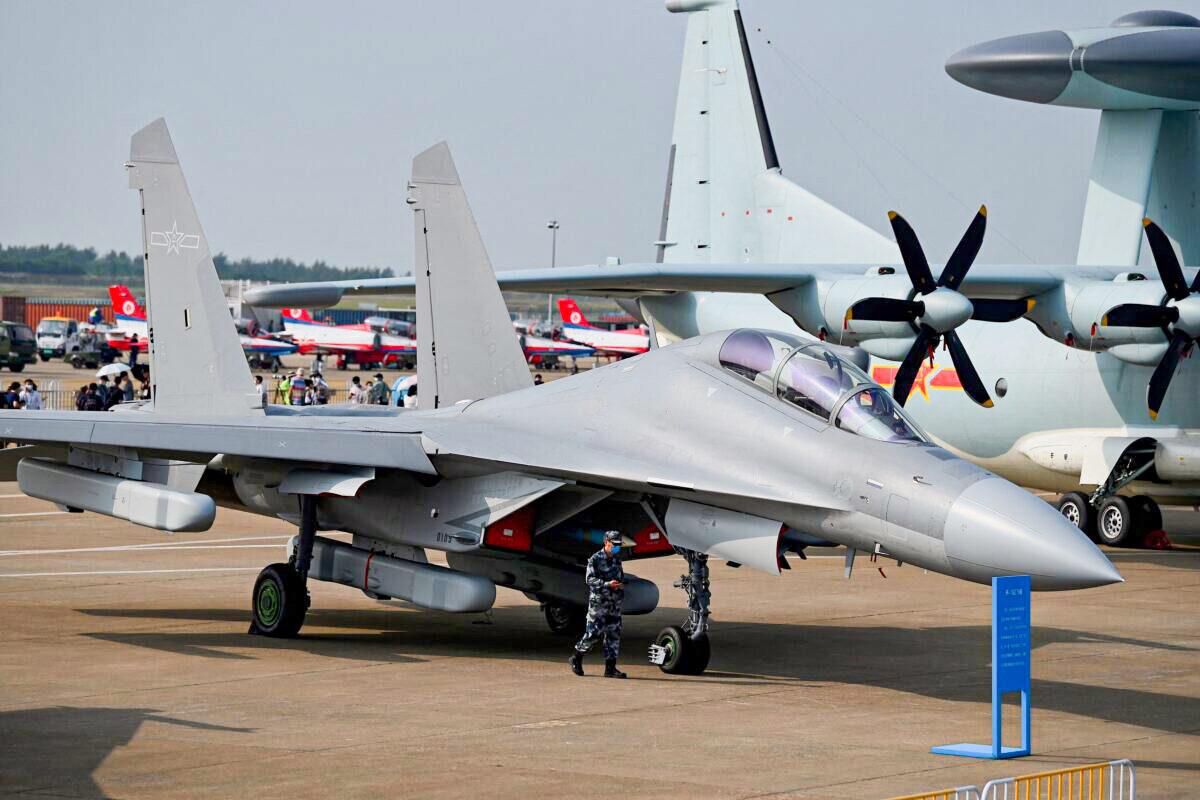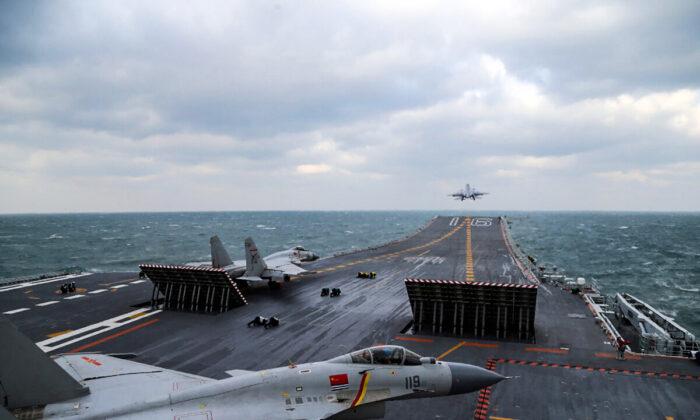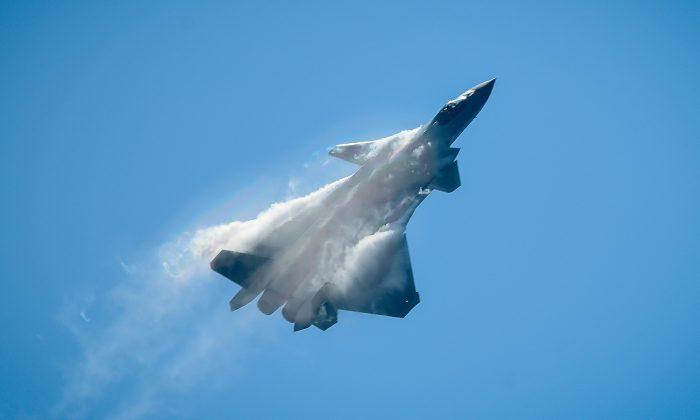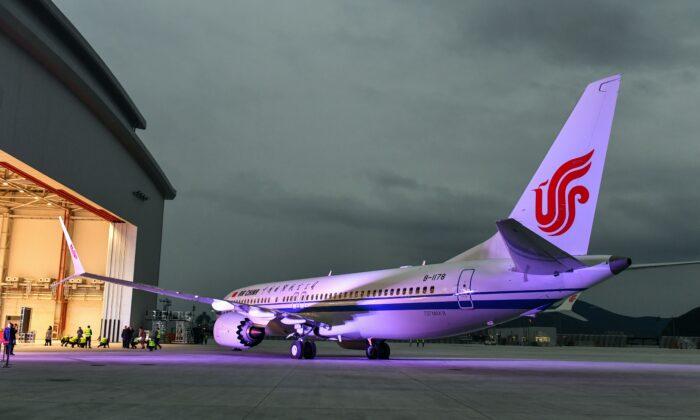Later this month, the People’s Liberation Army Navy is expected to launch its third aircraft carrier, its first “flattop” capable of conventional takeoff or landing operations.
With this new carrier, and the many to follow, the Chinese Communist Party (CCP) will begin using combined aircraft carrier battle groups and amphibious warfare battle groups to project power in pursuit of its goal of achieving global hegemony.
What is ominous is that while the U.S. Navy has been operating aircraft carriers for 100 years, it has taken China’s People’s Liberation Army Navy (PLAN) only some 40 years to develop and build a large flattop carrier with an advanced carrier air wing, which will be almost a capable as modern U.S. nuclear-powered carriers.
Component assembly for the latest Type-003 carrier started in May to July 2020 in Jiangnan Shipyard near Shanghai. However, component construction may have started from 2016 to 2017, for a total time of five to six years.
This compares to six to eight years for the construction of the first U.S. Navy Gerald Ford class nuclear-powered aircraft carrier or five years for the John F. Kennedy, the second of this class.
But the United States only has one shipyard, Newport News Shipyard in Norfolk, Virginia, capable of building one carrier at a time. In contrast, China’s Jiangnan shipyard can quickly build two Type-003 carriers simultaneously, and the Dalian shipyard has built one smaller 65,000-ton Liaoning class carrier.
Total displacement for the Type-003 is estimated at 90,000 tons, and it has a length of about 980 feet. It will operate three catapults that may utilize advanced electromagnetic launch (EML), which was rather difficult for the United States to develop for the U.S. Navy’s new 100,000-ton, 1,092-foot-long Gerald Ford class aircraft carrier.
The PLA Naval Air Force’s initial carrier strike fighter, the Shenyang J-15B, a much-modified copy of the 1980s Russian Sukhoi Su-33 canard (stabilizer in front of the wing) carrier fighter, will likely feature 4-plus generation capabilities like an active electronically-scanned array (ASEA) radar, 125-mile-range PL-15 air-to-air missiles, and an array of anti-ship/ground attack missiles.

It is likely that a dedicated electronic warfare (EW) variant of the J-15B will be developed, mirroring the U.S. Navy’s Boeing F/A-18G Growler EW strike fighter.
In addition, the PLAN is testing the Xian Aircraft Corporation KJ-600, a twin-turboprop airborne early warning and control system (AWACS) aircraft with a large radar radome, copying the configuration of the U.S. Northrop-Grumman E-2 Hawkeye. It should be expected that the KJ-600 will form the basis for anti-submarine warfare (ASW) and carrier cargo variants.
As the PLA has for over 20 years placed great emphasis on the development of unmanned combat platforms, the Type-003 can also be expected to eventually feature large unmanned combat aerial vehicles to help with ASW, surveillance, and strike missions.
Over the last decade, Chinese sources have not been clear whether the PLAN will build at least one more non-nuclear powered but likely improved Type-003, or just build one and transition quickly to serial production of nuclear-powered aircraft carriers, called the Type-004.
Production of a second Type-003 could be completed within five years, more rapidly giving the PLA up to four carrier battle groups that could overwhelm the one U.S. Navy carrier battle group based in Japan, better assuring that the PLA could mount a successful invasion of Taiwan.
With four carrier battle groups, the PLA could also more actively support CCP coercive diplomacy in the South Pacific, the Indian Ocean, Africa, and Latin America.
However, a more rapid transition to nuclear-powered Type-004 carriers would enable the PLAN to rapidly build the world’s first completely nuclear-powered carrier battle groups, which Chinese sources strongly suggest could include nuclear-powered escort cruisers and nuclear-powered underway replenishment ships.
The U.S. Navy has no plans to revive the production of nuclear-powered escort warships or begin producing nuclear-powered underway replenishment ships.
A completely nuclear-powered carrier battle group would give the CCP options to very quickly deploy naval power globally for combat or coercive missions. For example, from bases on Hainan Island, it could arrive in waters north of Australia in less than a week.
Even if the PLA just used its Jiangnan shipyard to produce four carriers per decade, it could accumulate to 10 PLAN aircraft carriers and deployed battle groups by the early 2040s.
Absent increased funding, the U.S. Navy will likely be hard pressed to fulfill plans to build and launch four Ford class carriers this decade to advance the replacement of aging Nimitz class carriers.
But having only one shipyard capable of nuclear carrier construction, the U.S. Navy will be hard pressed to maintain a fleet of 10 carriers, which means that due to maintenance cycles, only about five may be available for crisis reaction, not all of which would be in the Pacific.
To counter China’s rapidly deploying nuclear carrier battle groups, the U.S. Navy requires more “carriers” that are far less expensive to produce, can supplement the $13 billion Ford class, and can also pack impressive firepower.
Within the range of its ASBMs, guided by manned or unmanned support aircraft or even F-35Bs, such a smaller carrier could coordinate with land-based ASBMs or strike aircraft to destroy much larger PLAN carriers and their battle groups.
Such smaller carriers could also host several hundred Marines to work with larger Marine amphibious units, and/or Army Airborne forces, to preempt or counter global PLA amphibious and airborne assaults when needed.
A force of 10 such smaller carriers armed with a large number of ASBMs would better enable the U.S. Navy to deter Chinese naval-amphibious-airborne aggression that could emerge simultaneously at multiple global strategic locations—a threat that becomes increasingly likely as the PLA builds many more conventional and nuclear-powered aircraft carriers.





